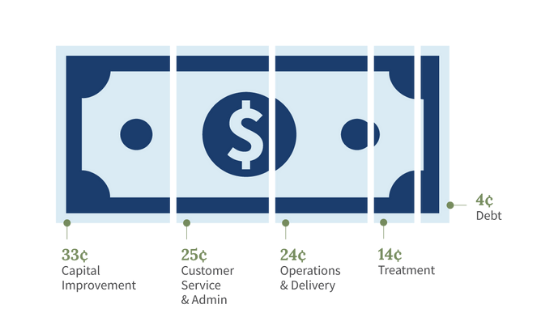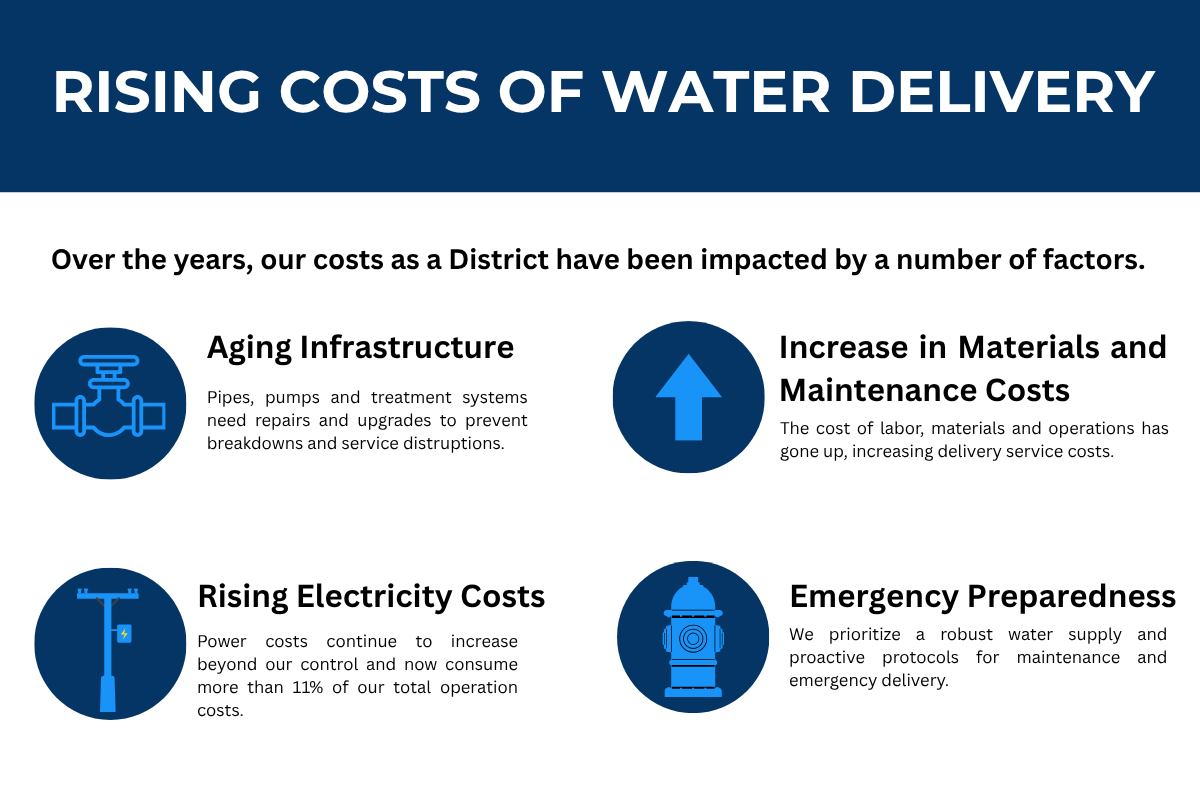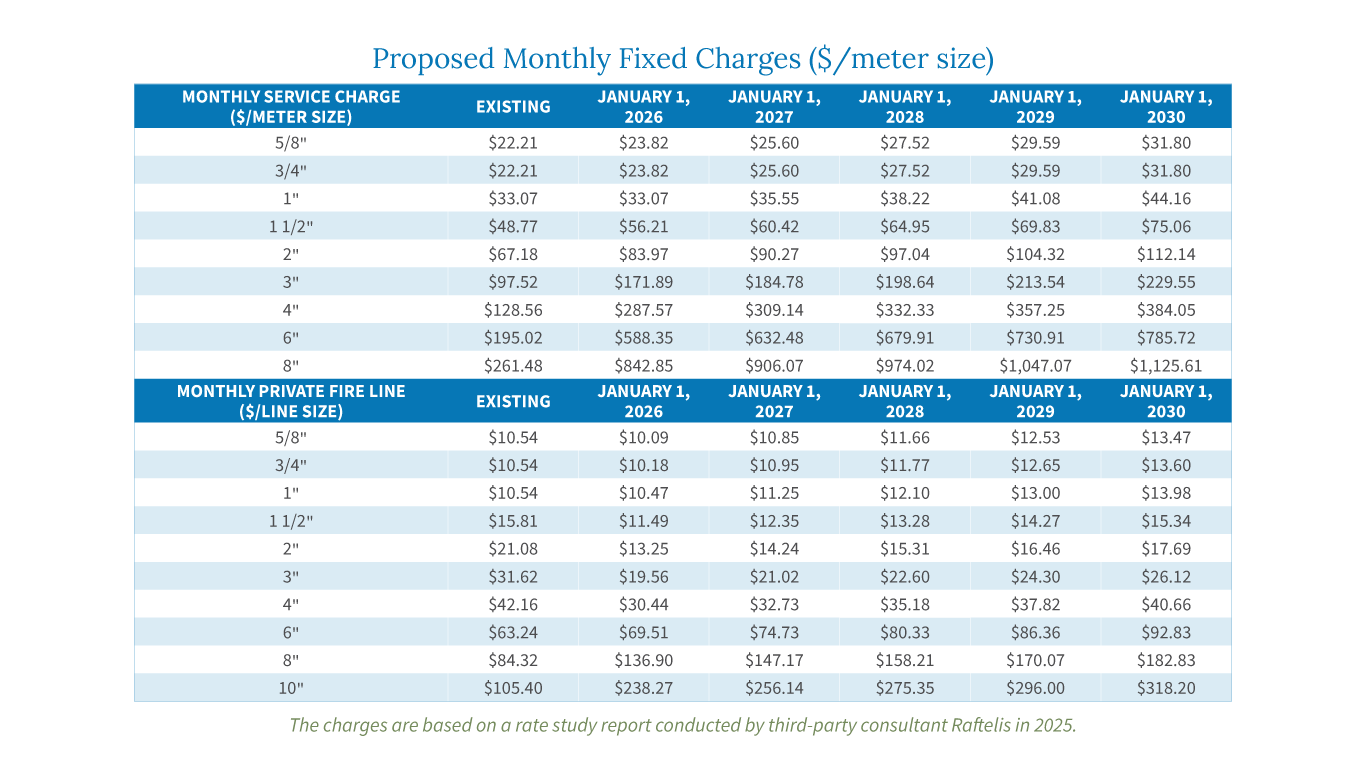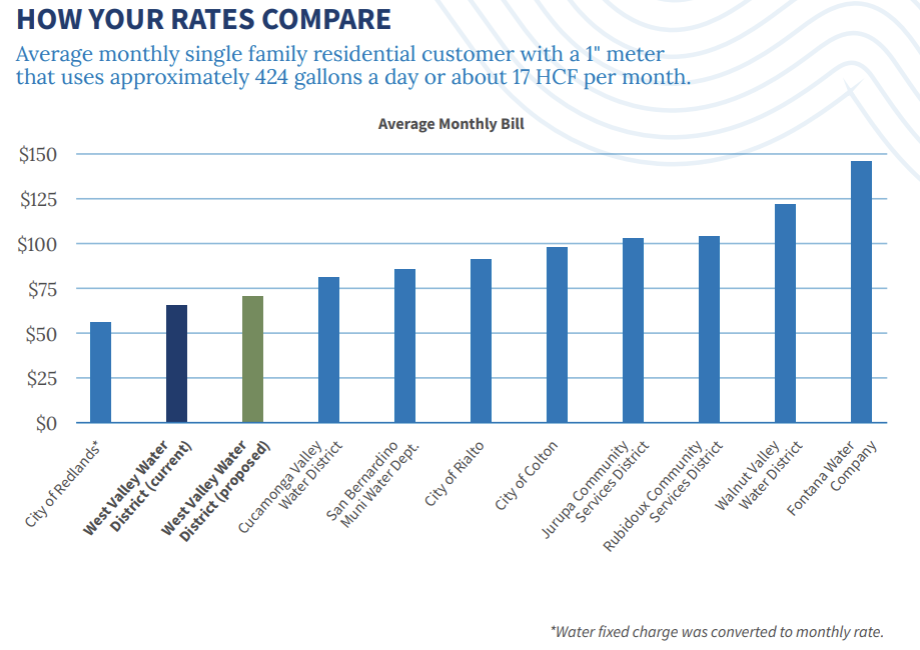2025 Rate Study
Your Water Bill: Understanding Charges
Your monthly water bill contains at least two types of charges: a fixed monthly Service Charge, and a variable charge for the amount of water you use (called consumption).
Where to Learn More
West Valley Water District is committed to proactive, two-way communication throughout the rate adjustment process to maximize awareness and minimize public uncertainty.
Hours of Operation and Contact
8 a.m.- 5:30 p.m. Monday, Wednesday, Thursday & Friday
9 a.m.- 5:30 p.m. Tuesday
Closed Saturday & Sunday
- Phone: (909) 875-1804
- Email: outreach@wvwd.org
- Online: wvwd.org/Prop218
Below is the Proposition 218 notice that was mailed to all WVWD customers before the public hearing to inform them of the proposed rate increases. The notice has also been translated into two languages.
Find Out if You're a Customer
West Valley Water District serves over 100,000 customers in the communities of Bloomington, Colton, Fontana, Rialto, parts of unincorporated areas in San Bernardino, and Jurupa Valley in Riverside County. Find out if you're a customer here.
Frequently Asked Questions
About Water Rate Adjustments
- About Water Rate Adjustments
West Valley Water District (WVWD) is committed to providing high-quality, and reliable water service. To keep up with rising costs and continue investing in our community’s water system, WVWD is considering an annual water rate increase through 2030, starting January 2026. The Board of Directors will host several workshops in October/November 2025 and a public hearing on Dec. 4, 2025, to discuss these changes.
- How often do you raise rates?
This is the first recommended rate adjustment in over 10 years, showing our commitment to keeping rates as low as possible. Adjusting rates now helps us maintain reliable service, prevent major system failures, and plan for future needs. The proposed adjustment would be an annual increase through 2030.
- When will the new rates go into effect?
If approved by the Board, the new rates will start in January 2026.
Rate Structure & Billing
- How are the new rates structured
Your water bill includes a fixed monthly service charge (based on your meter size) and a charge for the amount of water you use. If approved, the new rates will appear on bills issued on or after January 1, 2026.
- Will everyone’s rates go up by the same amount? How will this impact my monthly bill?
No, the impact will vary depending on your water use and meter size. Most residential meters are 5/8, 3/4, or 1 inch. Check your most recent bill to see which rates apply to you.
- What is a service charge versus a consumption charge?
Your bill has at least two main charges:
Service Charge: A monthly fee based on your meter size, covering the cost to keep water service ready for your home or business.
Water Consumption Charge: Based on how much water you use. Using less water means you pay less per unit (748 gallons).
You may also see other charges, like your city’s utility users’ tax.
- How your rates compare

Why the Increase is Needed
- What is the water district using the additional revenue for?
The cost to deliver water is rising due to aging infrastructure, inflation, emergency preparedness, and the need to support new growth. Every dollar goes toward maintaining and improving our water system—like upgrading pipes, pumps, and treatment facilities—to ensure reliable service now and in the future.
- What caused rates to increase?
Several factors:
- Aging Infrastructure: Pipes and pumps need repairs and upgrades.
- Rising Electricity Costs: It takes more energy to deliver water as our community grows.
- Higher Materials and Maintenance Costs: Labor and materials are more expensive.
- Emergency Preparedness: We invest in readiness for emergencies to keep your water safe.
- What is the district doing now to ensure long-term water supply reliability?
We’re investing in projects like:
- Lord Ranch Facilities: Improving system resiliency, fire-flow, and efficiency.
- Oliver P. Roemer Water Filtration Facility Expansion: Increasing treatment capacity for long-term sustainability
- Fire Resiliency: Installing new fire hydrants and backup generators to support emergency response and community safety.
These efforts help safeguard your water supply for today and future generations.
Proposition 218 Process
- What is Proposition 218?
Proposition 218 is a California law that limits how local governments can charge for services like water. It ensures transparency and protects taxpayers by requiring that charges are directly tied to the services provided. Learn more about Proposition 218.
- How can I view the rate study?
The cost-of-service study is available at wvwd.org/prop218 or at our main office. Printed copies can be mailed upon request.
- What is a written protest?
Under Proposition 218, property owners and customers of record may submit a written protest to the proposed rate adjustments. A written protest is a general statement opposing the proposed rates and will be used to determine if a majority protest exists. Only one written protest will be counted per parcel. A majority protest exists if protests are submitted on behalf of a majority of separate parcels subject to the rates. If a majority protest exists, the rates cannot be adopted.
To be valid, a written protest must:
- Include the property owner/customer name, parcel number, and/or service address.
- State that the letter responds to the proposed water rates.
- Be hand-signed (if mailed or dropped off) or include an image of the property owner’s/ customer’s signature (if submitted electronically) at the locations described below, provided they are received by 2 p.m. on Dec. 4, 2025.
- Written protests may also be hand-delivered during the public hearing, provided they are received by the Secretary of the Board prior to the close of the public comment portion of the public hearing on Dec. 4, 2025.
- What is a written legal objection?
Under Assembly Bill 2257, property owners and customers of record may also submit a written legal objection. For properties with multiple accounts, each account holder may submit one written legal objection. A written legal objection identifies substantive legal issues with the proposed rates.
To be valid, a written legal objection must:
Include the property owner/customer name, parcel number, and/or service address.
State that the communication is a legal objection.
Specify the grounds for alleging WVWD’s noncompliance with Proposition 218 in sufficient detail to allow WVWD to determine whether any adjustments to the proposed rates are necessary. Stating that the rates are too high, or illegal, is insufficient to constitute a valid written legal objection.
Be hand-signed (if mailed or dropped off) or include an image of the property owner’s/ customer’s signature (if submitted electronically) at the locations set forth below.
In order to be valid, written legal objections must be received by 5 p.m. on November 26, 2025 at one of the locations set forth below. Failure to submit a valid written legal objection by November 26, 2025 at 5:00 p.m., will bar any right to challenge the rates through a future legal proceeding. You may be limited to the legal issues raised in your valid written legal objection.
- Who can I contact with questions or concerns?
WVWD is committed to open communication.
- Call: (909) 875-1804
- Email: outreach@wvwd.org
- Visit: wvwd.org/Prop218
- Attend a workshop or public hearing, or schedule a one-on-one meeting.
- Is there a public hearing? How can I attend or comment?
Yes, workshops will be held at the dates and times below and a public hearing will be held on December 4, 2025.
Nov. 3, 2025, 6 p.m.
WVWD Headquarters
855 W. Baseline Rd., Rialto, CA 92376Nov. 5, 2025, 6 p.m. - during Bloomington MAC meeting
Ayala Park
17909 Marygold Ave, Bloomington, CA 92316Nov. 18, 2025, 6 p.m.
Kordyak Elementary
4580 Mango Ave, Fontana, CA 92336Nov. 19, 2025, 6 p.m.
Grace Vargas Senior Center
1411 S. Riverside Rd., Rialto, CA 92376Nov. 24, 2025, 6 p.m.
WVWD Headquarters
855 W. Baseline Rd., Rialto, CA 92376




